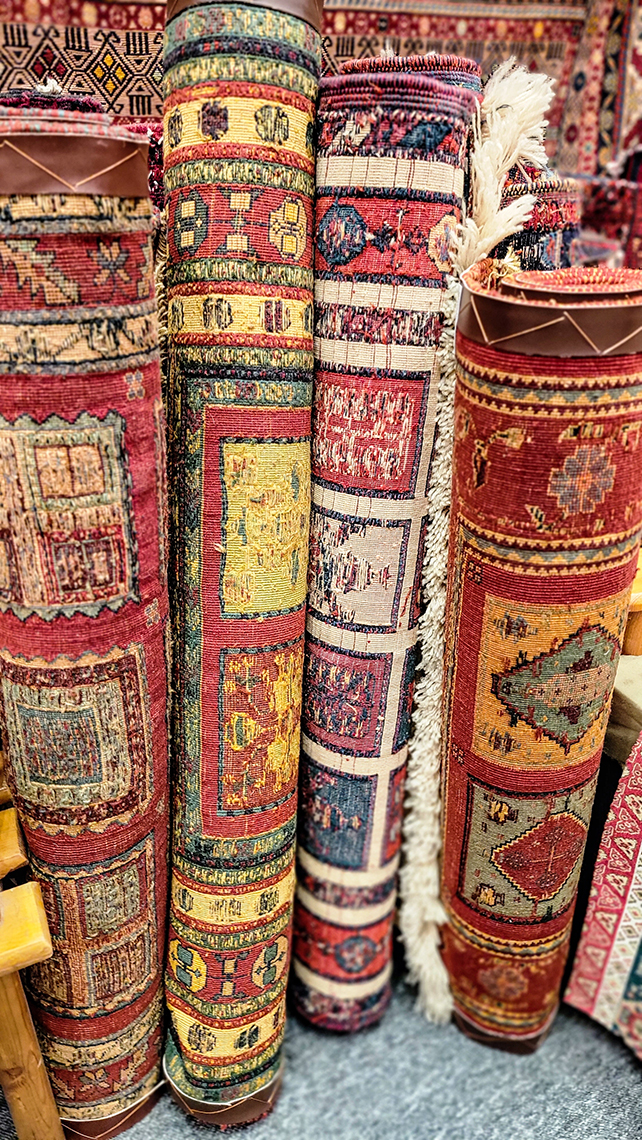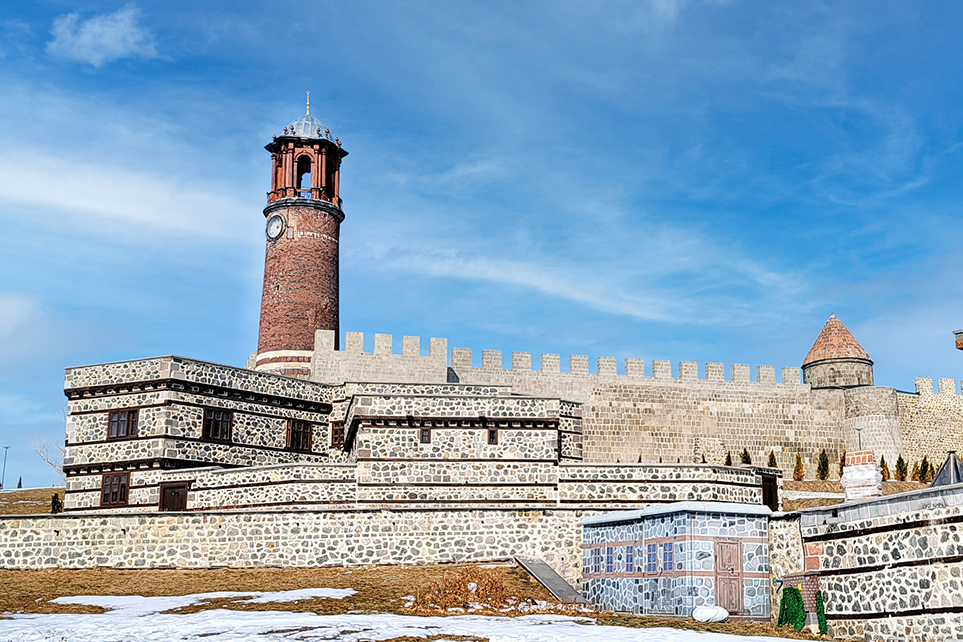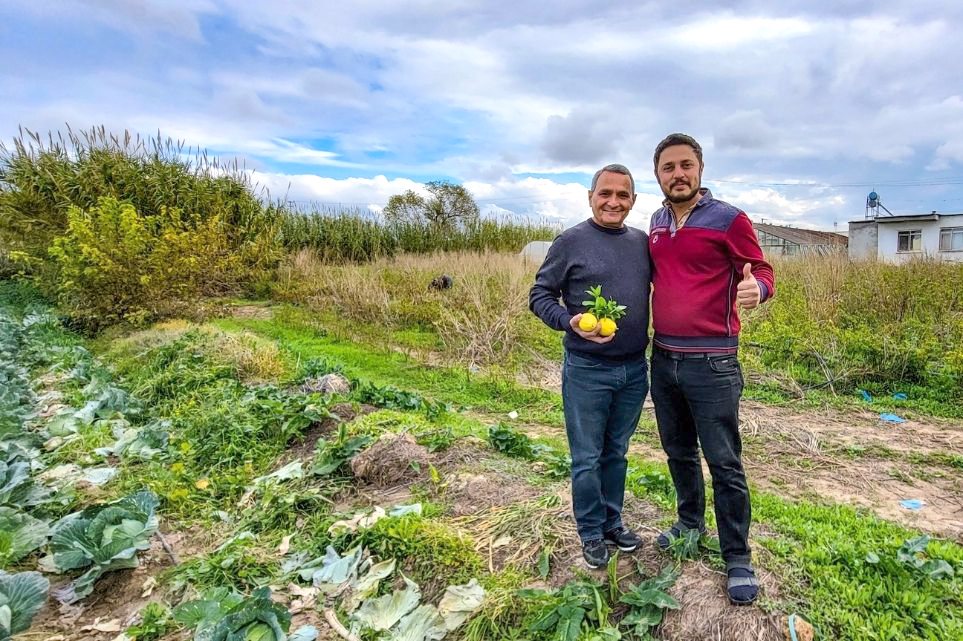
Eager to learn about the deep-rooted history and culture of the northeastern region of Turkey, I began to search for tours that could meet my desires.
It is February, and heavy snow has fallen on the mountains, shimmering in the sun. We are excited to embark on our four-day excursion to visit Van, Ani, Agri, Kars, and Erzurum.
DAY 1
VAN
Today was an early rise at 4:00 AM to be at the airport by 6:00 AM, flying on SunExpress Airlines from Antalya to Van. The flight went as planned, arriving in Van with several other passengers who signed up for the Dogu Express Tour.
Stepping out of the plane on the tarmac, I could feel the brisk cold air, requiring gloves, a heavy coat, scarf, and hat as the sun shined brightly demanding sunglasses.
After gathering our luggage, we loaded on the bus where we were introduced to our tour guide Savaş, his assistant Mehmet and the driver Selami. Savaş shared the schedule for the day and directed the driver to Sütçü Kahvalti Café for a hearty Turkish breakfast.

VAN LAKE
While enjoying our breakfast, we introduced ourselves to other tour group members. We quickly became friends with a lady traveling alone named Fatma. From the café window, fluffy snow covered the grounds, and beyond it is Lake Van, one of Turkey’s largest lakes.
It is one of the world’s few endorheic (a lake with no outlet) lakes, the size greater than 3,000 square kilometers (1,200 sq mi). Despite the high altitude and freezing temperatures, the lake rarely freezes due to high salinity.
After eating breakfast, I walked to the water’s edge, having fun stamping footprints in the snow. Surrounding the lake is white snow-capped mountains that look like white powdered sugar. My eyes could not help but stare at the beauty of the landscape around me.

AKDAMAR ISLAND
First on our itinerary is a boat ride on Lake Van to visit Akdamar Island. As we made our way across the water, the breeze made it a bit cold. So we moved to the back of the boat where the cabin would block the wind, and the sun could keep us warm. As our boat approached the Akdamar Island banks, we were anxious to disembark and explore the area.
This remote island is known for its ancient settlement of Armenians and natural beauty. The church is the sole remaining structure of the palace of the Aght’amar built by the architect Bishop Manuel between 915 and 921 AD. Although little remains of other structures, you can still see remnants of streets, gardens, terraces surrounding the palace and church.

The exterior church walls are exquisite with stone reliefs by Armenian master carvers, depicting Biblical scenes with Adam, Eve, Abraham, Dave and Goliath, and Jesus. Earthly themes, such as life at the palace, hunting scenes, and human and animal figures, also can be seen carved into the walls. In addition, the Abbasi art theme can be seen by grape vines interspersed with animals.
The frescoes that decorate the interior walls tell religious stories from the Bible. Most people were illiterate; therefore, the walls were painted for storytelling.


The local legend told is that a nobleman who fell in love with a beautiful girl named Tamar visited the island every night to see her. However, when he was crossing the lake in the night, his boat capsized, and he drowned, yelling for “Ach Tamar.” Waiting for her lover, she grieved so deeply she died of sadness. Hence, the island has been called “Ach Tamar” (Akdamar) ever since.
After hearing about the history and legends of the island, it was time to return to the mainland for the next destination on our itinerary to Urartu Hali Kilim.


URARTU HALI KILIM
The next place to visit in Van is Urartu Hali Kilim, a carpet school and store in Van.
After the fall of the Hittite empire, in the first millennium BC, a new kingdom called the Kingdom of the Urartu in this region of Turkey. The Kingdom of Urartu became known for its unique customs and traditions, setting them apart from Hittite and Seljuk.
The carpet designs are unique, linking it to the Urartu civilization. We had the privilege of learning about the weaving process and the rugs’ unique designs. Following the lessons on the history of the Urartu people and rug weaving, a variety of rugs were shown and made available for purchase.
It was very tempting to buy one of these rugs. The salesman was willing to deliver to our hotel or mail it to our home. However, after a long, intense discussion between my husband and I, we decided to pass up on the purchase.

MUNZUR BABA PEYNIRCILIK
Our next stop was at a local spice and cheese store in Van. Each region of Turkey prides itself on unique spices and cheeses. I honestly can’t distinguish the differences, but Turks can!
After sampling different cheeses, olives, and other lokum, it was time to get on the bus to our hotel for dinner and a good night’s rest. You can find them >>here<<


VAN ROYAL MILANO OTEL
Arriving at Van Royal Miland Otel, we unloaded our luggage in our room then had dinner with the tour group. The menu consisted of a traditional Turkish stew served with a salad, olives, and bread. After filling our bellies, it was time for bed.
DAY 2
Traditional Turkish breakfast was served at 8:30 AM, after which we loaded the bus (with our luggage) and got ready for our sightseeing adventure today.
VAN CASTLE
Our first site today was Van Castle. The Iron Age castle is a stunning ancient ruin, standing high upon the rocks west of the modern city of Van. The castle was once a part of the Urartu Kingdom in the 9th century BC. The castle has had many settlements over the centuries, the last being the Ottoman Empire. A mosque built by the Ottoman Sultan, Suleiman the Magnificent, can be seen within the grounds. It is a 10–15-minute walk up the steep hill to reach the castle. (Note: I do believe a “Kale” minibus is available for 2.50TL to ride)
At the base of the Van Castle is the Van Museum, sharing history, archaeology, and ethnography of Van Province, with a focus on the Urartian civilization.
- Museum Hours: Summer 8:00 – 19:00, Winter 8:00 – 17:00
- Admission:12.50TL or Museum Card
ARUBANI BEDESTENI SAVAT BAZAAR
Following the visit to Van Castle, we were driven to Arubani Bedesten Savat Bazaar to learn about the craftsmanship of silversmithing. Arubani is known as the Goddess of fertility and was the wife of the supreme God Haldi, which was a part of the Urartian society. Therefore, her name is often related to the word “artist.” Because of the rich mineral deposits in the area, many Urartians were attracted to live here. This made the Urartian people advanced in creating and designing jewelry.
Savat is black, a lead, silver, copper, and sulfur mixture. Handcrafted savat made with black-colored nib mud is applied on silver with the embroidered surfaces. Savat art was introduced to this region by the Urartians and became popular among the Ottomans.
Browsing the bazaar, looking thru the glass-cases, you could hear shoppers expressing their amazements over the detailed work of silver jewelry.

VAN CAT HOUSE
Next to this bazaar is the Van Cat House. The Turkish Van cats are a special breed in this region of Turkey. Legend has it that when Noah’s Ark arrived at Mount Ararat, two (white and red) cats leaped into the water and swam ashore. When the floodwaters receded, the cats set out for Lake Van, located about 121 km to the south of Mount Ararat, where they have lived ever since.
Turkish Van cats are also known as the “Swimming Cat” because of their fascination with water. Nothing is confirmed for their love for the water, but it has been noted that the cats have developed a type of cashmere coat that is water repellant. These cats dog-paddle in the water and come out relatively dry.
I found it most interesting that the cats have two different colored eyes. The breed was not recognized until 1969 with a full pedigree status by the Governing Council of the Cat Fancy. Although the Turkish Van’s are recognized as a unique breed around the world, Turks continued to see them as domestic cats. Today, Turkish Van cats are no longer permitted to be exported from Turkey.
- Note: You can purchase some special snacks and go inside the cat house to feed and pet the cats.
- Hours: Daily 9:30 – 18:00


MURADIYE WATERFALL
Driving 10 km from the city center of Van, on the River Bend-i-Mahi, is the scenic icy, cold, snow-covered Muradiye Waterfall. With freezing water streaming over the edge, falling 15-20 meters, it makes for a stunning view. A popular suspension bridge nearby is an excellent place for pictures and nature lovers to explore more of the park in the summer.
A terrace extends over the river with a waterfall backdrop, making it an excellent place for a selfie with my husband and me! I couldn’t help but stand there for a while, taking in the sounds of the rushing water and staring at its natural beauty.
Within the Muradiye Waterfall Park is Yaşarlar Restaurant, a small café offering warmth with a wood-burning stove and cup of warm coffee or tea. Standing in the cold temperatures for so long caused my hands and feet to feel frozen. The café is surrounded by window panel walls offering the Muradiye Waterfalls and nature to dazzle your eyes. In the summer months, many visitors will sit out on the terrace, enjoying the view and the cascading sounds of the waterfall.
- Admission: 5TL or Museum Card


PALACE of ISHAK PASHA
Climbing the mountainside near the city of Doğubayazıt, situated alongside the border of Iran, is home to one of the classic Ottoman palace architecture structures, Ishak Pasha Palace. This pearl has retained much of the opulence and grandeur of the empire despite having been abandoned for years.
The palace was constructed between 1685 to 1784, named after the local general, Ishak Pasha, whose family had long administered the region during the days of the Ottoman Empire. Pasha’s background is not clear, but it is believed he was a Kurd, and his family became incredibly wealthy due to the lucrative silk trade that passed through the city of Doğubayazıt.

You see a mix of Ottoman, Baroque, Persian, Seljuk, and Armenian styles as you wander through the palace. The Pasha wanted to have the most unique palace in the world. However, it is told that once the Armenian architecture completed the project, the Pasha cut off his hands so that he could never build something like it for his rivals.
The palace’s entrance is outlined in elaborate Persian-style muqarnas, inspired by Europe. You will see the Rococo or the Late Baroque style with curvy, highly ornamental patterns. Once you enter, you step into the first courtyard of the palace. This place was for workers of lower status. Here you will also find a dungeon where prisoners were kept until punishment.

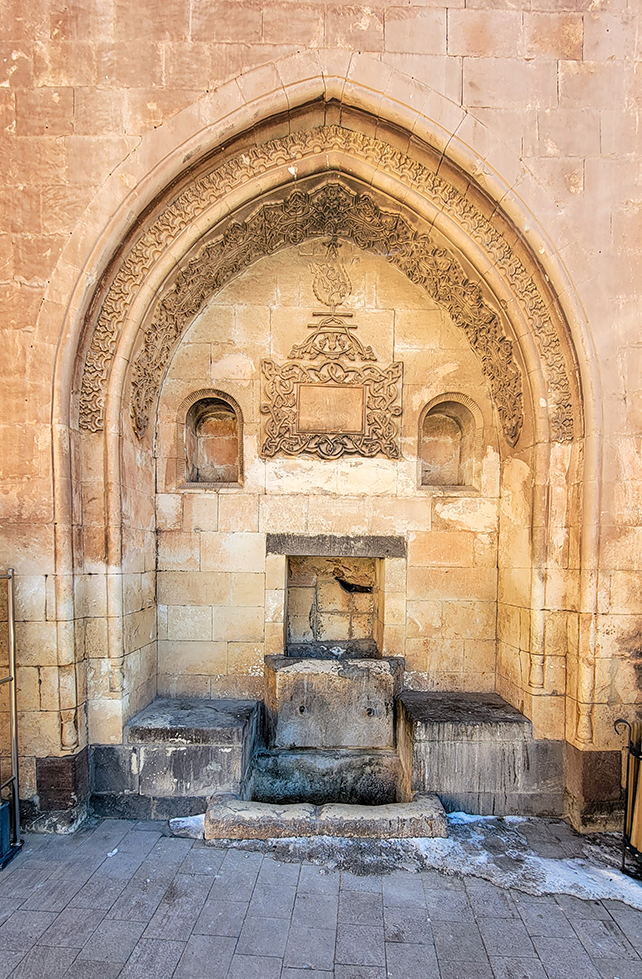
To the right of the entrance is the “Milk Fountain.” Legend has it that one tap would produce milk and the other water. The fountain still offers water today, with two benches on either side for sitting.
The second courtyard and staterooms are a Gothic-style portal decorated with lavish cypress tree motifs. One of the significant highlights is the mosque within the palace. Here you will find a beautifully carved octagonal tomb of Ishak Pasha himself (dated 1799).
Standing in the center of the second courtyard are two doors: one straight ahead, which leads to the harem section, and a Seljuk-portal to the right.

Within the right door is where state affairs were handled. Further in is the mosque, where you will find marble pillars and Baroque/Rococo ornamentation. Look up to see finely painted frescoes in the dome.
As you step outside the palace, look up to the mountainside for a beautiful view of the Doğubayazıt Castle. The fortress revealed some findings of stones dating back to the Urartian era. Therefore, it is assumed that the earliest settlement in the area goes back to around 800 BCE. The Ottoman Empire took over the region in 1514.
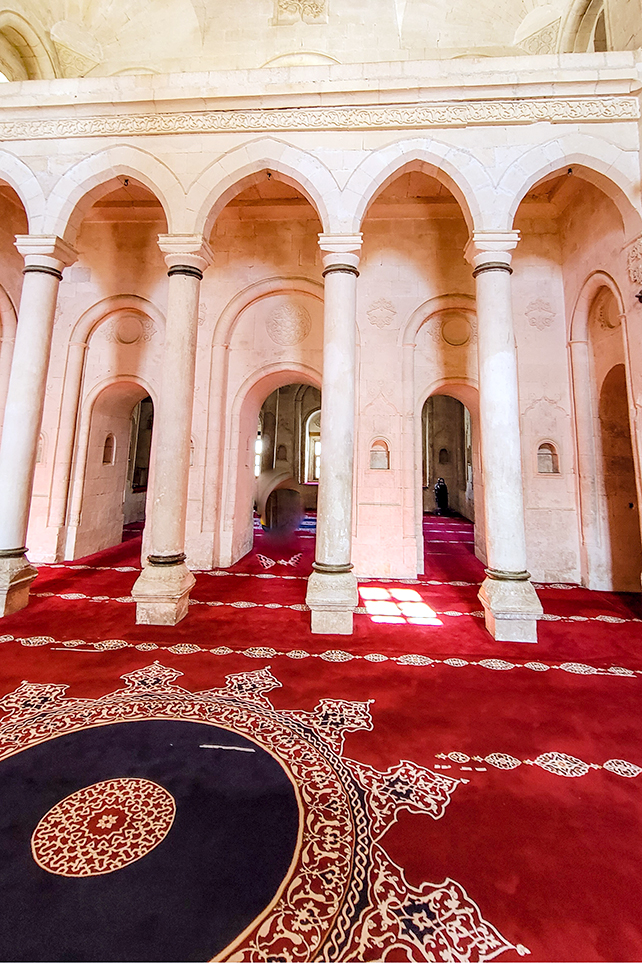

Today, this palace is extremely isolated, but once was the heart of the original Doğubayazıt city. Unfortunately, in 1930, much of the fortress was destroyed during the Kurdish uprising within Turkey. Thankfully, the palace and a few mosques remains are still intact.
When Russia occupied this region in the early 20th century, it was a defensive outpost. It wasn’t until 1950 did Turkey decide to restore and open it as a museum.

Ishak Pasha Palace is one of the most elaborate palaces in Turkey. Don’t miss this iconic gem on your travels in Turkey.
- Note: A gift shop and small restaurant are available on site.
- Hours: Open from Sunrise to Sunset
- Admission: 5TL or Museum Card
OTHER SITES TO SEE NEAR ISHAK PASHA PALACE
Northeast of the palace is Urartian rock tombs whose entrance is framed by larger-than-life relief figures. These tombs are located west of Doğubayazıt Castle, dating back to the 13th and the 9th century BCE. Doğubayazıt Castle clings to the cliffs east of the palace, with Eski Bayazıt’s still-standing 16th-century mosque below. The mausoleum of Ehmede Xani, a poet who wrote the Kurdish national epic Mem u Zin in the 17th century.
- Hours: Daily from surmise to sunset
- Admission: 5tl or Museum Card
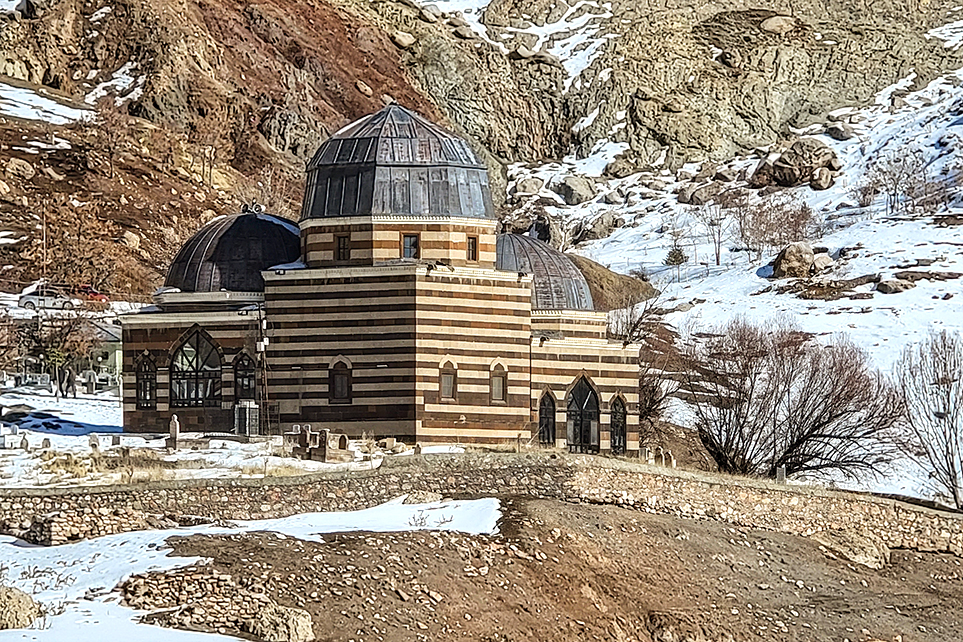
LUNCH
Time for lunch after seeing some amazing sightseeing! Today’s lunch in Agri is Saray Harman for a grilled chicken kebab with a side of bulgur, fresh onions, grilled tomato and pepper, and pita bread.

KARS
Kar is our next destination, about a 2.5-hour bus ride from Doğubayazıt. We have a two-night stay at Arifoglu Airport Hotel.
DAY 3
ANI ANCIENT CITY
After a lovely breakfast with Fatma and Susan, we boarded the bus to the Ancient City of Ani, about 40 km from Kars.
Between 961 and 1045, this ancient city was the capital of the Bagratid Armenian Kingdom. This iconic city was often referred to as the “City of 1,001 Churches,” although it actually had less. There are 823 buildings and caves within this site, and more are being discovered.
Because Ani City was within the major trade routes of the Silk Road, it served as a post for merchants and accommodations for travelers. The Silk Road Bridge was built over the Arpaçay River, linking Turkey to Armenia, increasing the flow of travelers to Ani.
Here are some of the stunning sites we saw while in Ani:
The City Walls of Ani encircle the city, protecting it from all kinds of enemy attacks. It is believed that most of the walls were built by King Smbat, who ruled between 977 and 989. As you enter the ruins, you will walk past the northern wall to enter the city.

The Church of St. Stephanos was built before 1218 based on the Georgian Catholicos Yepipan inscription engraved on one of the walls. On the south wall are two interesting figurative sculptures carved in bas-relief. These depict the Annunciation and the Visitation.

The Church of St. Gregory of the Abughamrents is probably the most photographed in Ani. Surrounded by an endless white landscape makes for an excellent photograph. It is believed to date back to the late 10th century, built as a private chapel for the Pahlavuni family. The church has six exedras and a dome over the center. Today, vandals have written over the frescoes on the interior but are still worth visiting.
The oldest building in Ani is the Atesgede (Temple of Fire), known as the “fire gem.” Here you will find four thick round columns with a diameter of about 1.30 meters, resting on cylindrical pedestals. The columns are made of small blocks to hold a stone roof. An altar was probably located under this roof.

The Great Cathedral is one of the most impressive church structures within the ruins. The church was initially dedicated to the Holy Mother of God. During the reign of King Smbat II, the church was built in 989 and completed in 1001. The Armenian architect, Trdat (who built the Hagia Sophia in Istanbul), is the designer and builder of the church. He is well respected in the Medieval Armenian community.
At the time of our visit, the church was undergoing a major renovation, so much of the exterior walls were covered in scaffolding. The interior was dark with a ribbed vaulted ceiling. The dome was destroyed by an earthquake in 1319.
When the Seljuk’s conquered Ani in 1064, they converted the church into a mosque; but returned to Christian usage in 1124.

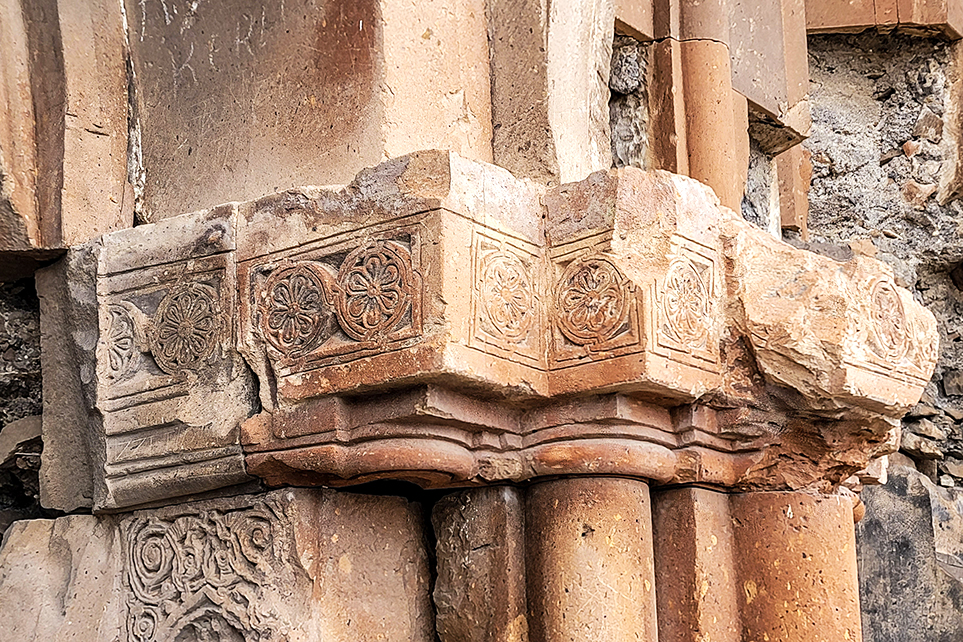


The Church of St. Gregory of Tigran Honents is the best-preserved structure of Ani. It is named after the Armenian merchant, Tigran Honents, who donated money to build the church. The church is dedicated to Gregory the Illuminator, who brought Christianity to the Armenian community.

The mosque of Ebu’l Manuçehr, built-in 1072, is the first Turkish mosque in Anatolia. The city of Ani was handed over to Shaddadid Dynasty, and the mosque was built in the name of Ebul Menucehr, the king of the dynasty. Today, the only part of the mosque that remained intact is the minaret. On the north wall are motifs of the Kufi alphabet, a geometric interpterion of Arabic letters.
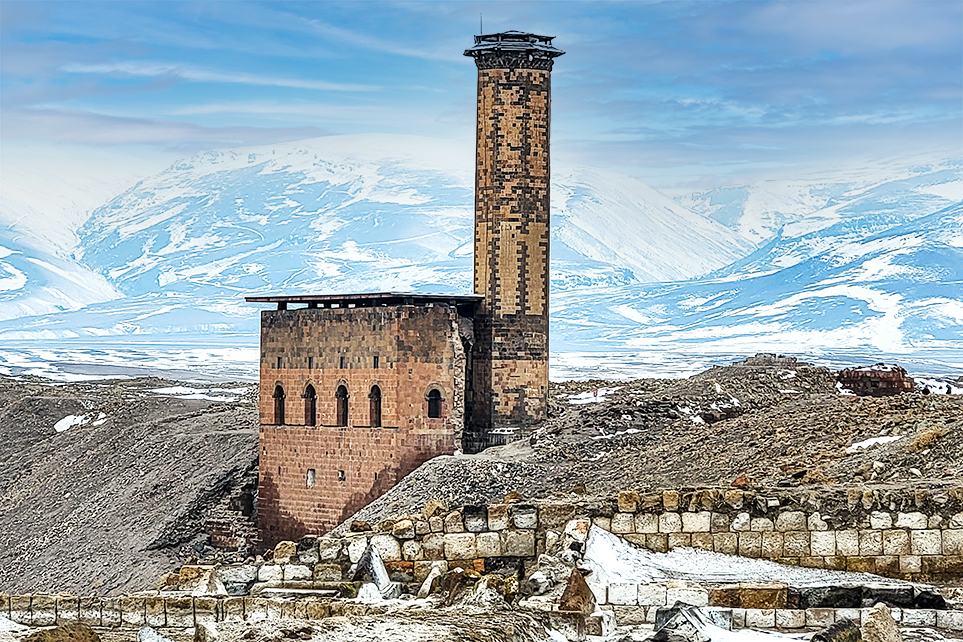
Church of St. Prkich (Halaskar), built-in 1035 AD in the southeast of Ani, close to the Great Cathedral, St. Gregory. Built by Hovhannes-Sembat III, the church was restored by Atabeks in 1291 and 1342 but later destroyed by a strike of lightning. Today, renovation is being done to preserve the remaining structure.

Surp Hrispsime (Church and Convent of the Virgins) was built by the wealthy trader, Tigran Honents, between 1000 and 1200 AD is another impressive church located on a cliff overlooking the Arpaçay River.
According to legend, Hripsime became a nun related to the Roman Imperial family. Emperor Diocletian fell in love with this beautiful lady. Hripsime and her fellow nuns, Shogagat and her abbess Gayane, fled to Rome to meet him. After traveling to Jerusalem, they ended up in Armenia, where the king of Armenia started stalking Hripsime. She refused his request and decided to become a nun. Later, Hripsime and other nuns became martyrs.
Prince Abulgharib Pahlavuni built the Church of Redeemer to be a shrine for a piece of the True Cross. It is noteworthy of its origins of ecclesiastical architecture built-in 1035 in Armenia. The geometrically sophisticated architecture is skillfully crafted, with many decorative exterior panels, containing an Armenian script that reveals details of the church’s history and its settlers.
- Hours: April 1 – Oct. 18:00 – 19:00, Oct. 1 – April 1 8:00 – 17:00, daily
- Admission: 22tl or Museum Card

CILDIR LAKE, ARDAHAN
Located at the border of Ardahan and Kars Provinces, on the edge of Armenia, Lake Cildir is the largest freshwater lake and the second largest lake in the Eastern Anatolia Region. The lake is excellent for fishing and often a destination for families in the summer.
The lake is completely frozen during the winter, with temperatures dropping to minus 10 degrees at night.
We are in February, in the middle of winter, and it is FREEZING! The ice covered the lake’s surface, making it an excellent day for a sleigh ride. So, as we bundled up with snow-gloves, a hat, a heavy coat, and a scarf, we walked out on the lake, hopping on a sleigh for a ride of a lifetime!

With teeth chattering while we waited our turn to ride the sleigh, we stood next to a wood fire, trying to stay warm. Then, our stagecoach driver whistled for us to climb aboard, joined by another couple on our tour, who seemed to be just as cold as we were.
As the horse took off stampeding across the snow-covered lake, we occasionally passed by a patch of ice with cracks, causing a spark of concern to fall into the ice-cold water. However, I continued to assure my husband and our traveling companions that it would all be okay!
Once we reached the center of the lake, the stagecoach driver offered to take our picture posing on the sleigh. With an occasional burst of sharp cold wind cutting across the lake, we were all quick to take a few pictures and be on our merry way back to the campfire.
The villagers spoke of the importance of horse-sleigh transportation to the Caucasian villages. So, to help rekindle sleigh transportation traditions, the locals decided to offer sleigh rides to tourists on Cildir Lake. This brought joy to the locals to see their history of horse sleighs being brought back to life! Other attractions to experience include Caucasian horse racing across the ice, javelin throwing, and ice fishing.
What a fantastic experience!
Eager to thaw out inside the Günay Canlı Alabalık Restaurant, near the lake, in a warm heated room with a warm cup of sahelp. After the numbness wore off, it was time to bundle back up and load onto the bus for Kars.
- Ride Time: 5 or 10 minutes
- Admission: 30TL or 60TL
KARS
Kars is located in the northeastern region of Turkey, stretching across the Kars River. The Armenians occupied the city during the 9th and 10th centuries. Later it was captured by the Seljuks in the 11th century. Subsequently, in the 13th century, the Mongols took over and later were incorporated into the Ottoman Empire in 1514. Finally, it was annexed by Russia in 1877-78 but later returned to Turkey in 1918.
It is the biggest cattle breeding province in Turkey. In addition, geese farms are rising due to the demand for goose liver and down feathers in Europe.
GOOSE FOR LUNCH
Speaking of geese, Kars is known for a special goose dish called “kaz.” Unique to this region of Turkey, this dish is most popular in the winter months. Being open-minded to try new things, I ordered kazi ve bulgar pilavi (bulgur pilaf) at Aleksander Pushkin Restaurant.
These native geese graze the grasslands throughout the year, and then in the winter, just before slaughter, they are fattened by feeding on grains.
At a glance, I thought the waiter had brought the wrong order as the meat was shredded and much darker than expected (almost like a roast). After confirming with the waiter, he reassured me that it was indeed goose! As I filled my fork and slowly brought it to my lips, I doubted that it would satisfy my taste buds. Boy, was I wrong! The goose was very tasty (a little tough), and the side dishes of bulgur and green pepper added so much more flavor.

Kars Citadel (Castle)
Kars Castle was built-in 1153, incorporating an earlier Armenian fortification, serving as an essential central trade route from Anatolia to the Caucasus. The castle has suffered a turbulent history. Destroyed in 1356 by the troops of Timur but then later rebuilt by the Ottomans in 1579. Again, the castle was destroyed by the Iranian Shah Abbas and restored in 1636. Later, during the 19th century, the castle was conquered by Russia. When they abandoned Kars, the castle started to decay, left empty for decades.
Today, the Kars Castle is a backdrop for the old town of Kars. It is free to explore.
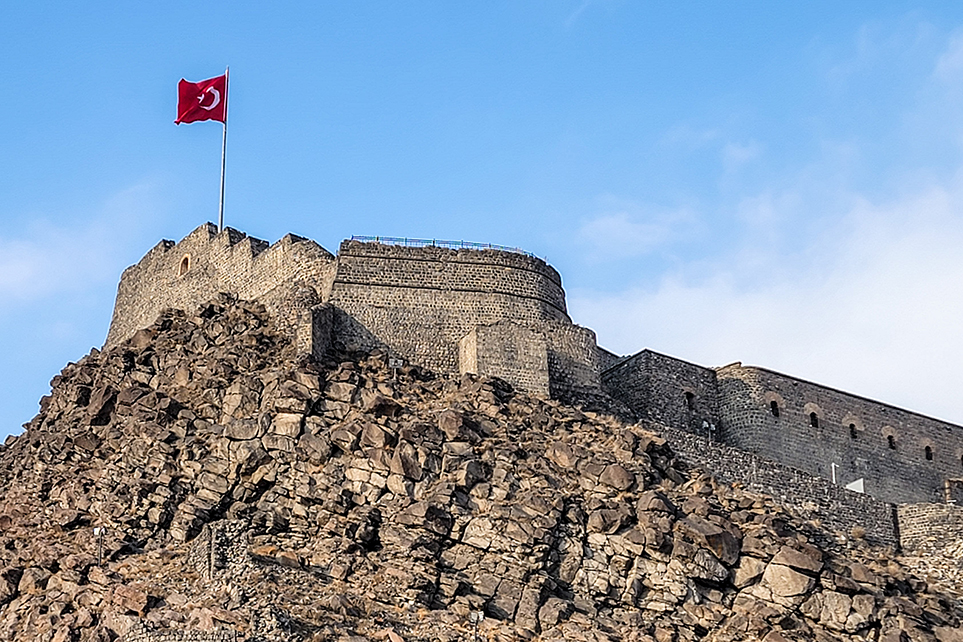
St. Arak’elos Cathedral, the Church of the Apostles
Near Kars Castle is the Church of the Apostles (the 10th century Church of the Apostles), with an interesting mix of architecture. The church was built between 932 and 937 AD, during the Bagrath Kingdom. It constitutes a domed tetraconch atop a square base with four apses. Within the dome is a relief depiction of the Twelve Apostles.
The church was converted into a mosque under Muslim rule in 1064 and named it Kümbet Mosque. Interestingly, under Russian rule, the mosque was converted into a Russian Orthodox Church, and after the Turks regained control in 1918, they turned it back into a mosque.

Stone Bridge
Arched over the Kars River on the south side of Kars Castle is the historical Stone Bridge built-in 1579. The bridge collapsed during a major flood in 1715 but was later reconstructed in 1719. Unfortunately, when Russia occupied the city, they destroyed the inscriptions on the bridge to try and erase the Turkish past.
As my husband and I strolled across the bridge, we enjoyed a peaceful and relaxing walk down the promenade while admiring the historical site.

Kars Military History Museum of Caucasus Front
If you are a history buff, visit the Caucasian Front War Museum in the bastion, built-in 1803 during the Selim period. The soldiers in the fortress were murdered during the night by Russians who attacked Kars in 1828.
This museum is interactive, with eight main halls filled with important events from 1828 to the proclamation of the Republic. Historical documents such as letters written by soldiers containing information about the wars in the Caucasian Front are showcased. In addition, an Infirmary, medical ward, and kitchen are animated to portray the daily military life of wartimes.


COFFEE BREAK
Late in the afternoon, I felt like I needed a coffee break from all the sightseeing, so we crossed the street from the Kars Castle for a cup of chai latte and pistachio baklava at Seyidoğlu Baklavalari.

KARS CHEESE SHOP
Kars is known for their cheese, a Turkish version of gruyere cheese. The history of gruyere goes back to 1882. What is believed to make this cheese so unique is the type of cow and plants the cattle fed on, making the milk golden color with a distinctive fragrance and a balance of fat. In addition, it is a hard cheese with a distinct aroma.
The tour stopped at Malakans Peynrcilik (Cheese) to sample Kars cheese, other cheeses, nuts, seeds, and Turkish candies. The store name, Malakan, is a family name that settled in Kars in 1877 and was one of the first producers of Kars Kashar Cheese and Kars Gruyere Cheese. My husband loved tasting all the different cheeses while I was busy tasting the candies. Finally, we settled on a flavor of Kars cheese and walked out with a block to take home.

TRADITIONAL TURKISH DANCING
Tonight, we enjoyed watching traditional Caucasian dancing at Raskolnikov Café Restaurant across from the Kars Stone Bridge, offering excellent entertainment. It is Valentine’s Day, and the restaurant is packed with couples sharing an evening celebrating romance with a dinner and show.
Day 4
Dogu Express (Eastern Express) TRAIN
One of the main reasons for this trip was to have an opportunity to ride the Dogu Express Train. Social media was constantly promoting this train ride. After speaking with a few travelers and reading up on others’ experiences, I was eager to have my chance!
Dogu Express began operation in 1924, starting in Ankara only reaching Erzurum. To reach Kars, passengers had to transfer onto a gauge train. In 1962 the broad-gauge line was converted into a standard passenger train making its way from Istanbul to Kars without changing trains.
Dogu Express offers a sleeping car for longer distances, or you can ride as a passenger. In addition, a dining car is available for meals or snacks as you ride the train. Each passenger is issued a seat assignment, although once the train starts to move, you can roam about freely, changing your seat (as long as it is not assigned).


As the train rolled away from Kars Station, a rippling landscape with fluffy white snow with an occasional burst of thick forests became the scene out the window. The brightly shining sun created shadows of the mountains onto each other. An animal’s footprints could be seen occasionally, making a line across the snow or a tree with bare branches covered in snowflakes glittering in the sun.
We arrived at Erzurum Station four hours later, our tour’s final stop.

ERZURUM
The history of Erzurum extends back to 4000 BC. One of the most important preserved is the Byzantine city walls of the Erzurum Fortress. Erzurum was captured and ruled by many different nations starting with Hurries until the Ottomans, later taken over by the Modern-day Turkish Republic. One of the most significant rulers at one time was Alexander the Great.

Cifte Minarelli Medrese is one of the most significant buildings with twin blue tile minarets. Once a religious school is now home to artifacts.
Ulu Mosque was built in 1719 and earned the name “Atabey Mosque” due to its devotion to Sultan Atabeg Kizil Arslan. The mosque has twenty-eight rectangular-shaped pillars that carry the top cover and twenty-eight illuminating windows.
Üç Kümbetler Tombs are three mausoleums dating back to the 14th century belonging to rulers of Erzurum. Emir Saltuk Türbesi’s tomb with inscriptions dating back to the 12th century stating that he was the ruler.

Across the street is Paşa Bey Konağı., a historical Erzurum house. The entrance had two knockers making two different sounds. One knocker let the homeowner know that a male was at the door. The other knocker notified of a woman at the door. The home had a particular octagon timber roof design to handle the house’s heating. The tour guide walked us room to room, sharing the functions and how the daily life of Erzurum people utilized the house.
Here is the last visit to Erzurum, >>CHECK OUT ERZURUM <<.

The Dogu Express Tour with GeziExpress Tours turned out to be quite entertaining! We typically do not like tour groups because we don’t want to be on someone else’s schedule, but our guide, Savaş, and his team were excellent, and the travelers in our group were all friendly and easy-going. Through this experience, we gained new knowledge of the northeastern region of Turkey but gained lasting friendships and hope to visit them soon.
Enjoy your travels! Please read my blogs about other exciting places around the world at Traveling Lens Photography.
If you want to read more follow me on Facebook, Instagram, or Pinterest as I share my journey.
Happy Travels!







